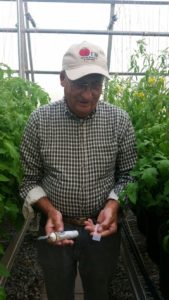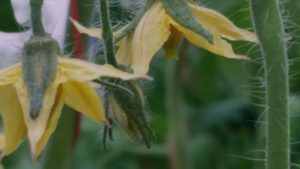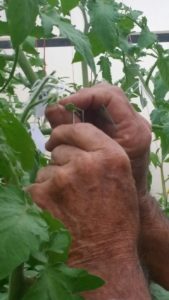
Who are your heroes? A politician, a celebrity, an author, an athlete, a religious figure? For many Western North Carolina tomato growers, their hero is an unassuming tomato researcher by the name of Dr. Randolph(“Randy”) Gardner https://www.ces.ncsu.edu/fletcher/staff/rgardner/. About three years ago I interviewed local tomato grower, William Shelton of Shelton Family Farm in Whittier, NC.http://buildupdietitians.blogspot.com/search?q=shelton#!/2014/07/farmer-story-1-walking-through-fields.html William spoke in almost reverential terms of Randy Gardner. Dr. Gardner’s Mountain Majesty tomato had basically saved William Shelton’s farm by giving him a variety that could withstand certain diseases and provided a tomato with improved color and flavor that consumers were looking for. This summer I visited Cassandra Benfield Bare at her farm in Marion, NC.http://buildupdietitians.blogspot.com/search?q=cassandra#!/2016/06/going-to-food.html Cassandra also talked about Dr. Gardner and his invaluable advice about tomatoes. It seemed to both of these farmers “Randy” Gardner was a hero, larger than life.
Dr. Gardner is a quiet, almost shy man, and both times I’ve seen him he has been wearing a baseball cap. His darkly tanned face indicates lots of time spent outdoors. Though Dr. Gardner retired from NC State University in 2008, he continues to work daily on tomato breeding. He has ten “benches” (tables where plants are grown) that the Mountain Horticultural Crops Research and Extension Center in Mills River provides him to do tomato breeding research, and he visits the greenhouse daily. Since he’s retired I asked if his wife minded and he ducked his head and gave a slow smile and responds, “No, she knows it makes me happy….and it keeps me active”.
Dr. Gardner was born in Virginia and grew up on a small family farm of about 30 acres that had crops as well as cows and chickens, he recalled that he “… always liked working with the vegetables.” He attended Virginia Tech for both his undergraduate and Master’s degrees in horticulture and went on to Cornell University for his Ph.D in Pomology. He talked about the 1970’s in Western North Carolina when most of the tomatoes being grown in Western NC were varieties developed for mature green harvest in Florida, “The tomatoes weren’t good here, we needed disease resistant varieties that were adapted for summer vine ripe production in this area.” The first variety that he introduced was Mountain Pride and he went on to develop other varieties, his “Mountain series” including Mountain Delight, Supreme, Majesty, Fresh and Magic.
I asked Dr. Gardner some questions that consumers often have about plant breeding:
- Sometimes consumers think licensing of seeds is bad, why are your tomato seeds licensed? Universities and companies who do seed research and breeding license need to help pay for the cost of development and research, which can take years and be very expensive. We license the F1 hybrid, that’s the breed that I develop from crossing two parental lines, to one company and we (NC State) select the company we license it to. Seed companies basically apply to buy the license and we select which one we’ll sell it to based on what other seeds they sell and how good of a job we think they’ll do promoting it.
- Are farmers limited to what seeds they can buy? Do they have to buy from big companies? No, there are huge numbers of seed companies that farmers can buy from and a wide variety of seeds. Farmers are free to grow what they want but of course, if they are growing for specific regions or purposes ( supermarkets, food service etc) or want specific traits, they will look for certain attributes and buy from companies who sell those types of seeds. For example, when farmers are growing for supermarkets they need consistency in size and flavor. This is important for transport and display. If farmers grow the wrong type of tomato it could mean too much loss and waste and could cost the farmer a lot of money or even put them out of business.
- What would you say to people who claim there are fewer varieties of tomatoes now than there used to be? There are many more varieties now, although most are F1 hybrids as opposed to the open pollinated varieties grown years ago. It used to be that people sometimes called the same tomato by different names, that was pretty common in different parts of the country, but now we can check the genes and can identify when they are actually different varieties.
- How do you think tomato breeding has changed? We’re breeding more for flavor than we used to. I have also bred tomatoes with a crimson gene that has a higher lycopene amount.(Note: Lycopene is an antioxidant that has health benefits.) The development of molecular marker technology to identify naturally occurring genes of interest in tomato, particularly for disease resistances, has greatly improved breeding for specific characteristics.
- What about genetic engineering? Why do you think some consumers are afraid of it? I don’t use genetic engineering on my projects, but I think it’s because there’s a lack of information and so much misinformation out there. People are too far removed from farming and may have no connection to a farm so they often don’t understand what’s really going on in agriculture. Also, some people are scared because they think that the effects of genetic engineering have not been sufficiently studied and that there may be unknown effects on human health from genetic traits transferred to food crops from other species through the process of genetic engineering. ( Note: A recent report in 2016 by the National Academies of Sciences identified NO health concerns tied to current crops being grown using genetic engineering.http://nas-sites.org/ge-crops/2016/05/16/report-in-brief/)

We drove down to the greenhouses where Dr. Gardner conducts his breeding experiments. His benches were full of healthy green tomato plants, many with yellow blossoms. Dr. Gardner explained that he uses only traditional breeding and then showed me the simple tools of his trade, a pair of tweezers to emasculate (remove the pollen bearing anthers from the immature flowers of the female parent), a modified electric toothbrush ( it acts like the bee to collect pollen from the male parent), and a glass slide that holds the pollen for transfer to the flowers of the female parent plant.

I continued to ask Dr. Gardner questions about tomatoes and agriculture:
- How do you explain to consumers about why and how farmers use pesticides? I don’t have to use pesticides in these greenhouses and if you are growing in your backyard then you can probably get away with not spraying pesticides although fruit yields and quality will likely be reduced. But if you grow outside commercially, then you have to protect your plants and fruit against diseases and insects to optimize fruit yield and marketable qualities. It’s hard to grow tomatoes here in Western North Carolina because of the cool nights and wet weather. There’s a real problem with early blight and late blight. Farmers don’t spray because they want to, it’s expensive and time consuming…farmers spray to control problems.
- Why do you think people are often unhappy with tomatoes they buy in a supermarket? Sometimes the tomatoes have been picked green so they may not be totally ripe went they are transported or even when consumers see them in the store, so they won’t be as sweet and tasty. Many tomato varieties, including those produced in greenhouses, have been developed with emphasis on high yields, cosmetic appearance, and shelf life, instead of emphasis on fruit flavor and texture. The best tomatoes are those harvested as vine ripes from local production, and this is what people use as a benchmark for tomato quality , but unfortunately, these are not available on a year-round basis. Never refrigerate your tomatoes as they will lose flavor. If you can, let them sit out for a day or two and this will make them ripen more. You also don’t want them to sit out too long as they’ll eventually start to lose flavor.
My last question to Dr. Gardner was about his favorite recipe with tomatoes. He thought for a minute and then with a slow smile replied, “I just like a slice of tomato, I don’t eat them every day, I put a little salt on it to bring out the flavor.”
